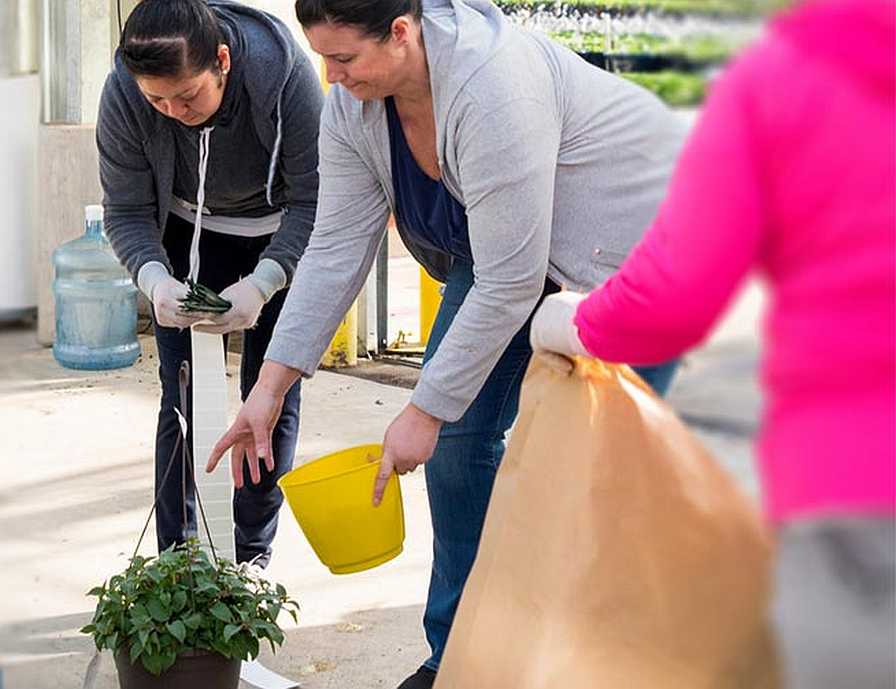Boost Greenhouse Productivity With Lean Principles

Lean is a proven method for eliminating waste that results in more value to customers, delivered at a lower cost, in a shorter time, with fewer defects and less human effort.
Photo courtesy of The Peters Company
Using Lean process improvement methods, Robinson Nursery of Yamhill County, OR, embarked on a series of activities this year to create better flow in its shipping operation. Robinson has been applying Lean principles for a number of years in various places in the business. The company began this particular improvement in May during a two-day process-mapping workshop with the Oregon Lean Consortium.
The company wrote about it in its October 2018 newsletter.
“The journey of a plant was mapped, from being pulled out of production to being loaded on the shipping truck,” the newsletter stated. “The steps that added value to the product were identified, and we began looking for ways to eliminate the rest. The team discovered that much of their frustration came from batch processing, poor communication, and unclear standard work.”
Then, in September, Robinson Nursery partnered with The Peters Company on a three-day rapid improvement event in its container yard, focused on the process of pulling and preparing trees for shipping.
“Our innovative group of problem solvers included those who have been a part of the plant pulling process for years,” says Marie Robinson, Marketing Director for Robinson Nursery. “Key team members, supervisors, managers, and office staff helped dissect the process, identify issues, and create a better system. Everyone was eager to jump in, looking for ways to eliminate waste, add value, and eradicate inconsistency.”
How Lean Principles Were Deployed
Prior to this event, plants had been moved to a central location where machines netted each rootball and crew members placed them onto transfer pallets for movement to the shipping area. After studying the process, the team applied the principles of waste reduction, one piece flow, and standard work.
First, they identified seven types of waste in their shipping process:
- Transportation – moving product, materials, or information
- Inventory – storage or buildup of product, materials or information
- Motion – movement of people
- Waiting – people, product, materials, or information
- Overproduction – producing more than necessary
- Overprocessing – doing more than necessary
- Defects – scrap or rework
One waste the team clearly saw was overprocessing. The product was picked up and put down several times. Another was waiting — people were waiting for instructions, and the product was waiting in between process steps.
This led to another Lean concept: One Piece Flow.
One Piece Flow is where items proceed one at a time through production. It’s the opposite of batching. A “piece” can be the raw materials, work in process, or the final product.
“One piece flow is the fastest way to translate raw material into finished products,” says Rick Peters, President of The Peters Company. “Anytime you see inventory or raw materials building up between steps in a process, you have an opportunity to remove waste.”
The team created a mobile system for netting the plants.
“Machines are now moved to the bed where the plants are pulled,” the company wrote in its newsletter. “One piece flow eliminates wasted motion, traffic jams, and overprocessing.”
Labor Benefits With Lean
By applying Lean principles, Robinson Nursery was able to cut its lead time in half on this process, with 30% fewer product touches and a smaller crew — just six people instead of 11 previously utilized.
“Prior to this event, it took three days to process a full truck order, about 3,200 trees,” the company reported. “That same order can now be done in about a day and a half with greater accuracy and less strain on the team.”
With the new process in place, the team examined the logistics and standard work was documented to properly train the rest of the crew. This helps to assure fewer defects and better consistency. Documenting standard work also shows respect for those doing the job, particularly because they helped create the new way of doing the job as a team.
“The numbers are exciting, but what is even more gratifying is the new attitude in that division of our company,” Robinson says. “The time and opportunity that was given to share ideas and trial different methods was a truly empowering and meaningful bonding experience for everyone involved.”
To view this case study with photos, visit Petersco.net/case_study. The original newsletter is available at RobinsonNursery.com.
What is the Oregon Lean Consortium?
Lean is a proven method for eliminating waste that results in more value to customers, delivered at a lower cost, in a shorter time, with fewer defects and less human effort. The system engages everyone in the organization to continuously improve.
The Oregon Lean Consortium is a tight-knit group of companies that work together to learn Lean principles and methods, and then apply them to processes in each other’s businesses. Each company engages three people who are trained and serve on improvement events—called “kaizen”—at different sites throughout the year.
These kaizen events (highly focused, rapid improvement activities) involve direct, hands-on changes at the hosting company with a professional facilitator. The team makes rapid changes to immediately reduce waste and help create standard work for a process.
The Oregon Lean Consortium is now open to new member applications for 2019. It begins training in January, and will hold events through the year. For more information, visit http://www.petersco.net/consortium for an application form.








